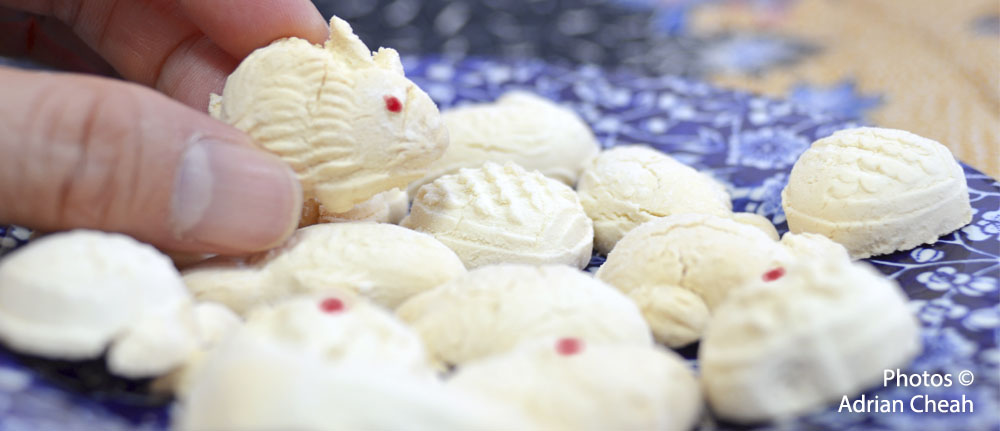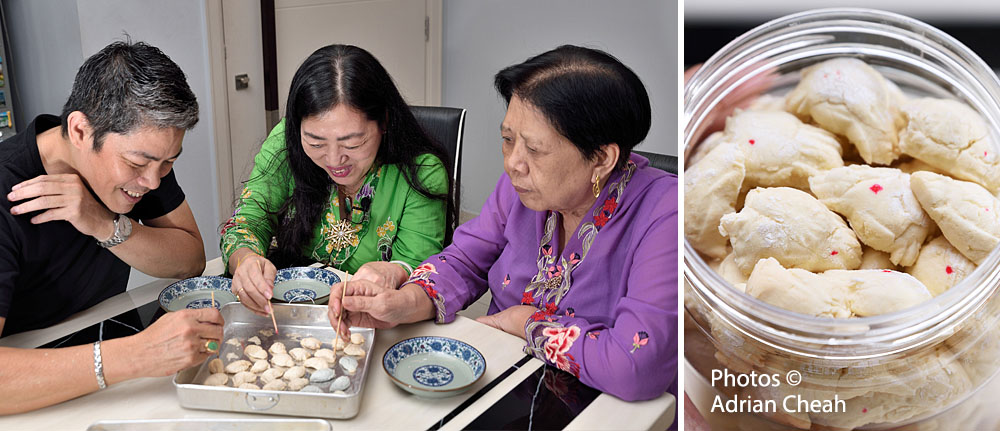Nyonya Kuih Bangkit with a difference. Why not?

Nyonya Kuih Bangkit is a classic Chinese New Year cookie, cherished alongside favourites like Kuih Kapit, peanut cookies and pineapple tarts. Loved by Penangites, this petite, animal-shaped treat captivates with its sweet pandan fragrance that greets you at the first bite. Its slightly crisp outer layer encases a powdery softness that melts in the mouth.

Making Kuih Bangkit is a simple yet meaningful process. The dough is pressed into beautifully carved wooden moulds, many of which are still available for purchase in Penang today. Intricate designs carved often feature Chinese zodiac animals or floral patterns. Some fortunate families continue to use moulds passed down through generations, each holding a piece of history. I am fortunate to have a few of these cherished heirlooms. Using these moulds feels like stepping back in time, rekindling the memories of my childhood, when I would help Mum prepare a fresh batch of Kuih Bangkit. After baking, each cookie is brought to life with a tiny red dot of artificial cochineal, usually applied to the eye of each animal using a toothpick.

Interestingly, cochineal, also known as carmine, was historically derived from the crushed bodies of the cochineal insect, native to Central and South America. Today, modern versions of the dye no longer rely on actual insects. The term "artificial" refers to the synthetic form of the pigment, which is now produced through chemical processes, though it still imparts the same vibrant red hue.

In February 2020, Jason Ng and I filmed a video at Lily Wong’s apartment on how to make traditional Nyonya Kuih Bangkit. The recipe below is courtesy of Lily. She has perfected the recipe from years of experimentation.
Traditionally, Kuih Bangkit made by the Nyonyas in Penang has always been white. When I first suggested adding a splash of colour to the cookies, Lily was horrified! She believed it would be a sacrilegious act to the die-hard traditionalists. But after much persuasion, she agreed to my challenge, and together, we ventured into uncharted territory, using natural ingredients for the colours – daun pandan for a soft green, blue pea flower for a delicate baby blue, and red dragon fruit for a gentle pink. My vision was to create a palette of soft pastels to accompany the traditional white ones. The day was filled with laughter and creativity, and what we created was truly beautiful. I wholeheartedly encourage you to add some colour to your next batch of Kuih Bangkit. They will be more visually striking and will certainly bring a burst of festive cheer, especially during Chinese New Year.
Try the recipe below and make a batch of coloured Kuih Bangkit.

Ingredients
- 300 g tapioca flour
- 100 g cornflour
- 6 strips of pandan leaves, cut into strips of about 1-inch length
- 2 egg yolks
- 120 g castor sugar
- 150 ml of coconut cream (add a pinch of salt)


Method
-
Fry the flour together with strips of pandan leaves over low heat till the leaves become dry and crispy for about 20 to 30 minutes. Remove the leaves and allow the flour to cool. Put the flour into an airtight container and let it rest for a day or two.
-
Beat the egg yolks with the sugar till light and fluffy.
-
Add half the coconut cream and mix well.
-
Add the sifted flour and knead the dough till it comes together. Leave about 25 g of the flour for the dusting of the moulds. (Use a muslin cloth, tie the flour up within a pouch.)
-
Add the remaining coconut cream to the dough.
-
Continue to knead the dough till it becomes softer.
-
Divide the dough and colour them accordingly.
-
Dust the moulds by padding with the pouch.
-
Press the dough into the moulds.
-
Use a knife to cut out excess dough.
-
Gently knock out the pressed dough from the moulds.
-
Arrange the moulded cookies on a tray and bake in a preheated oven at 160°C for 15 to 20 minutes.
-
Use a toothpick to make a tiny red dot on each Kuih Bangkit.



Additional notes
When you have a dough that is too “wet”, you will find difficulty in dislodging the cookies from the moulds. Add some flour and re-knead it. When you have a “dry” and crumbly dough, add some coconut cream and re-knead it.
Remember to cover any remaining dough with a damp cloth while you are busy moulding the Kuih Bangkit. This will prevent the dough from drying out if left exposed.

Enjoy making a batch of Kuih Bangkit with a twist. Just remember, these delicate cookies require tender loving care, as they are brittle and can crumble easily under the slightest pressure.
---------------------------------------------------------
Written and photographed by Adrian Cheah
February 2020 © All rights reserved